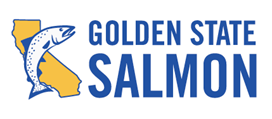Fish Report for 10-12-2023
Spring run salmon face extinction - extreme measures being taken

by GSSA Staff
10-12-2023
Website
Low Flows, High River Temperatures and Pollution Force Emergency
Condor-Style Plan to Save Salmon Species
California Water Policies Decimate Threatened Central Valley Spring-Run Chinook Salmon
AMERICAN CANYON, Calif. – The California Department of Fish and Wildlife and the National Oceanic and Atmospheric Administration (NOAA) Fisheries announced an emergency action plan to capture Central Valley spring-run Chinook salmon juveniles in a move to prevent extinction of the threatened species. The captured juvenile spring-run will be raised to adulthood at UC Davis, in an effort to save this run’s unique genetic heritage.
Spring-run salmon were declared threatened in 1999 under the Endangered Species Act and experienced catastrophically low survival in 2021. This news is another blow to California’s salmon stocks and a beleaguered fishing industry impacted by the complete closure of the 2023 commercial fall-run Chinook salmon season. The closure has resulted in the loss of tens of thousands of jobs in California and Oregon, erased incomes for thousands of families, and threatens the survival of coastal communities.
“We applaud and support the California Department of Fish and Wildlife and the National Oceanic and Atmospheric Administration Fisheries for implementing this critical action to save wild salmon,” said Scott Artis, executive director of Golden State Salmon Association. “But this current situation could have been avoided if Governor Newsom, state agencies and the Bureau of Reclamation had focused on the biological needs of salmon as much as they cater to industrial agriculture’s thirst for water to grow almonds and other nut crops for export.”
Rejecting calls from Golden State Salmon Association, environmental organizations, environmental justice groups and tribes over the last decade to restore the health of California’s rivers, the Bureau of Reclamation (BOR), even during drought, has continued to divert the water salmon need to survive from the Sacramento River. The BOR has the authority to reduce these diversions and provide life-saving cold water for salmon. Unfortunately, it has failed to do so even as the warning signs of devastating losses and low salmon returns continue to pile up.
During the last few years, spring-run Chinook have continued to be exposed to harmful water temperatures and dangerously low water flows in our rivers, including the Sacramento. In Butte Creek, the Central Valley’s spring-run Chinook salmon stronghold, high river temperatures in the summer of 2021 forced salmon into limited river habitat, which resulted in outbreaks of disease that killed nearly all adult spring-run fish prior to spawning. The following year, only 5,132 wild spring-run salmon returned to spawn. In August 2023, a breach on PG&E’s Butte Canal, which carries water to their De Sabla Powerhouse, caused rust colored sediment to spill into and thoroughly pollute Butte Creek. The pollution event resulted in the destruction of salmon habitat and killed threatened spring-run fish.
The State Water Board continues to fail to adopt and implement new flow and temperature requirements to protect salmon – to replace failed standards that were adopted in 1995. And on the Feather River, the California Department of Water Resources continues to stall spring-run restoration actions that it agreed to in 2009.
“The Newsom Administration and the Bureau of Reclamation are pillaging our natural resources at the expense of people and wildlife, and using climate change as a scapegoat for policies that have reduced flows in our rivers to a trickle and raised temperatures to levels that kill salmon eggs. Enough is enough,” said Artis. “We obviously did not learn our lesson on how to prevent a California condor-like situation. Instead, agencies continued to ignore the problems facing salmon. They have let the population drop to a fraction of 2021 numbers on Butte Creek. Now we are at a point when a single pollution event results in a population catastrophe. And we find ourselves having to implement a capture program to prevent extirpation. If our leaders do not want to stand by as salmon runs become extinct and fishing jobs are lost, the time to act is now. Californians should send three words to Governor Newsom – temperatures and flows.”
Currently, the State’s fall-run Chinook salmon industry is valued at $2.1 billion in economic activity and 33,000 jobs annually for California and Oregon in a normal season. Industry workers benefiting from Central Valley salmon stretch from Santa Barbara to northern Oregon. This includes commercial fishermen and women, recreational anglers (fresh and salt water), fish processors, marinas, coastal communities, equipment manufacturers, hotel and food industry, tribes, and others.
California’s Sacramento-San Joaquin River system supports four distinct Chinook salmon runs: fall, late-fall, winter and spring. The winter- and spring-runs have seen periods of alarmingly low numbers and are designated as endangered and threatened, respectively, under the Endangered Species Act. The fall-run, which is currently the only commercially and recreationally fishable stock, was closed in 2023 for the third year in California’s history, due to low numbers of adults that survived the hostile conditions encountered in Central Valley rivers. The late-fall run has been eliminated from most of its native spawning habitat. All four Chinook salmon runs are dependent upon cold water flows and releases from reservoirs for mitigation and spawning.
Golden State Salmon Association (www.goldenstatesalmon.org) is a coalition of salmon advocates that includes commercial and recreational salmon fishermen and women, businesses, restaurants, native tribes, environmentalists, elected officials, families and communities that rely on salmon. GSSA’s mission is to restore California salmon for their economic, recreational, commercial, environmental, cultural and health values.
Photos and Video (California Department of Fish and Wildlife):
Download Photos and Video of Spring-run Chinook Collection at Deer Creek Oct. 10, 2023
< Previous Report Next Report >

Website Hosting and Design provided by TECK.net
